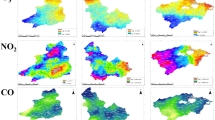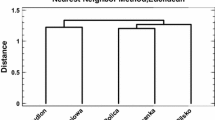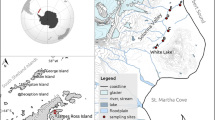Abstract
This paper provides data on variations in the contents of As, Sb, Ni, V, Pb, Cu, Cr, Au, Zn, Sc, and Al, measured in the thalli of a saxicolous lichen species,Xanthoria calcicola Ochsner s.l., collected in northeastern Sicily, near an industrial zone and along a belt crossing areas of known ores containing sulfides of heavy metals. A total of 91 lichen samples were collected on roof tiles (39) and on rocks (52). In the industrial zone, analysis of lichen thalli revealed high contents of nickel and vanadium, decreasing at increasing distances from the source of contamination. The results have also revealed the versatility ofXanthoria calcicola in geochemical prospecting for heavy metals such as Pb, Zn, As, Au, Sb, Ni, V, and Cu. The contents of these elements in the analyzed lichens highlight the same geochemical associations observed in prospecting surveys on samples of river sediments and identify similar anomalies. Interpretation of data in terms of enrichment factors (EFs) turned out to be particularly useful.
Similar content being viewed by others
References
Ahmadjian V (1967) The lichen symbiosis. Waltham, Massachusetts: Blaisdell. VIII + 125 pp., illustrated.
Amman K, Herzig R, Liebendoerfer L, Peter K, and Urech M (1992) Bioindikatoren Das Lebendige als Beurteilungsmass von Unweltschaeden. Ascom fuer Bern, Die Menschen und das Klima, Ascom-Vortragsreihe Winter/Fruehjahr 1991. Ascom Holding 20–30
Athanassiadis YC (1962) Preliminary air pollution survey of vanadium and its compounds. A literature review. NAPCA Pub. No. APTD 69-48 Raleigh, North Carolina: USDHEW.
Atzori P and Ferla P (1992) II basamento cristallino prealpino dei M. Peloritani. Atti Convegno “Giornate di studio su metamorfismo, magmatismo ed evoluzione dell'Arco Calabro-Peloritano.” Milazzo, October, p 17
Bargagli R and Barghigiani C (1991) Lichen biomonitoring of mercury emission and deposition in mining, geothermal and volcanic areas of Italy. Environ Monit Assess 16:265–271
Bargagli R, Iosco FP, and Leonzio C (1985) Monitoraggio di elementi in tracce mediante licheni epifiti: Osservazioni nell'area industriale di Rosignano Solvay. Inquinamento 2:33–37.
Bargagli R, Iosco FP, and D'Amato ML (1987) Zonation of trace metal accumulation in tree species of epilitic lichens belongingto the genusParmelia. Cryptogam Bryol Lighenol 8:331–337
Becquerel P (1948) Reviviscence duXanthoria parietina desséché avec sa faune, six ans dans le vide et deux semaines a — 189°C: ses consequences biologiques. C R Acad Sci 226:1413–1415
Brown DH (1976) Mineral uptake by lichens. In: Brown DH, Hawksworth DL, and Bailey RH (Eds), Systematics association, special volume 8, Lichenology: Progress and problems, pp 419–439, Academic Press, London
Cavender WS (1964) Arsenic in geochemical gold exploration. AIME Preprint 64-L-73. pp 16–20
Corigliano F, Di Pasquale S, Primerano P, and Mavilia M (1992) Air pollution from acid ashes. IU-17B.06 In: Papers from the 9th world clean air congress, towards the year 2000: Critical issues in the global environment. Montreal, Quebec, Canada
Czehura SJ (1977) A lichen indicator of copper mineralization, Lights Creek District, Plumas County, California. Econ Geol 72:796–803
De Vivo B, Lima A, Catalano G, and Chersicla A (1993) Detailed geochemical survey in the Peloritani Arc (northeastern Sicily, Italy): Evidence of gold anomalies. J Geochem Explor 46:309–324
Ferla P (1982a) Aspetti strutturali e composizionali delle sequenze cristalline prealpine nei M. Peloritani. In: Catalano R and D'Argenio B (Eds), Guida alla geologia della Sicilia Occidentale. Societa Geologica Italiana, Guide Geologiche regionali. 93–96, Palermo
Ferla P (1982b) Inquadramento geologico-petrografico delle mineralizzazioni metallifere dei M. Peloritani Rend Soc Ital Mineral Petrol 38:1075–1091
Garty J (1985) The amount of heavy metals in some lichens of the Negev Desert. Environ Pollut Ser B 10:287–300
Goyal R and Seaward MRD (1981) Lichen ecology of the Scunthorpe Heathlands II-Industrial metal fallout pattern from lichen and soil assays. Lichenologist 13(3):289–300
LeRoy LW and Koksoy M (1962) The lichen-a possible plant medium for mineral exploration. Econ. Geol 57:107–111
Locardi E and Triscari M (1991) Evidenze di minerogenesi recenti ed attuali dei Monti Peloritani. Mem Soc Geol Ital 47:527–535
Markert B (Ed) (1993) Plants as biomonitors. Indicators for heavy metals in the terrestrial environment. Weinheim: VCH. pp 265–284
Nieboer E, Ahmed HM, Puckett KJ, and Richardson DHS (1972) Heavy metal content of lichens in relation to distance from a nickel smelter in Sudbury, Ontario. Lichenologist 5:292–304
Nieboer E, Richardson DHS, and Tomassini FD (1978) Mineral uptake and release by lichens: an overview. Bryologist 81:226–246
Nimis PL, Castello M, and Perotti M (1993) Lichens as bioindicators of heavy metal pollution: A case study at La Spezia (N Italy). In: Markert B (Ed), Plants as biomonitors. Indicators for heavy metals in the terrestrial environment. Weinheim: VCH. pp 265–284
Omenetto P, Meggiolaro V, Spagna P, Brigo L, Ferla P, and Gujon J (1988) Scheelite-bearing metalliferous sequences of the Peloritani Mts., northeastern Sicily. In: Boissonnas J and Omenetto P (Eds), Mineral deposits within the European Community. Heidelberg: Springer Verlag. pp 179–198
Oteri F, Saccá C, Stagno F, and Triscari M (1986) Confronto tra composizione chimica e modalità giaciturali di alcuni minerali metalliferi dei M. Peloritani (Sicilia NE). Rend Soc Ital Mineral Petrol 41(1):41–52
Puckett KJ (1980) An analysis of the element content of lichens from the Nortwest Territories, Canada. Can J Bot 58:2073–2089
Puckett KJ, Nieboer E, Gorzynski MJ, and Richardson DHS (1973) The uptake of metal ions by lichens: A modified ion-exchange process. New Phytol. 79:329–342
Triscari M and Saccá C (1982) Scheelite at the ancient “S. Carlo” Sb-Cu-Ag mine, Fiumedinisi, Messina. Mineral Petrol Acta 26:159–168
Tuominen Y (1967) Studies on the strontium uptake of theCladonia alpestris thallus. Ann Bot Fenn 4:1–28
Tuominen Y and Jakkola T (1973) Absorption and accumulation of mineral elements and radioactive nuclides. In: Ahmadjiian V and Hale ME (Eds), The Lichens. London: Academic Press, pp 185–223
Vaccarino C, Cimino G, Tripodo MM, Lagana G, Lo Giudice L, and Matarese R (1983) Leaf and fruit necroses associated with vanadium-rich ash emitted from a power plant burning fossil fuel. Agric Ecosyst Environ 10:275–283
Author information
Authors and Affiliations
Rights and permissions
About this article
Cite this article
Dongarrà, G., Ottomello, D., Sabatino, G. et al. Use of lichens in detecting environmental risk and in geochemical prospecting. Geo 26, 139–146 (1995). https://doi.org/10.1007/BF00768735
Received:
Accepted:
Issue Date:
DOI: https://doi.org/10.1007/BF00768735




